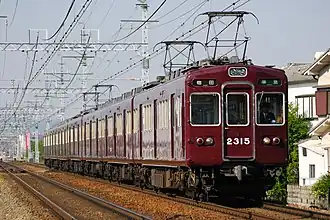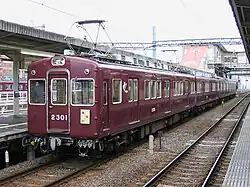Hankyu 2300 series (1960)
| Hankyu 2300 series | |
|---|---|
 A 2300 series on a Semi-express service, April 2007 | |
| In service | 1960–2015 |
| Manufacturer | Naniwa Kōki |
| Family name | Auto Car |
| Number built | 78 vehicles |
| Number in service | None |
| Number preserved | 2 vehicles and 1 cab end |
| Number scrapped | 75 vehicles |
| Formation | 7 (formerly 2/3/4/5/6) cars per trainset |
| Operators | Hankyu Railway |
| Depots | Katsura |
| Lines served | Hankyu Kyoto Main Line Hankyu Senri Line |
| Specifications | |
| Car body construction | Steel |
| Car length | 19,000 mm (62 ft 4 in) |
| Width | 2,808 mm (9 ft 2.6 in) |
| Height | 4,120 mm (13 ft 6 in) |
| Doors | 3 pairs per side |
| Maximum speed | 110 km/h (70 mph) |
| Traction system | Resistor control (originally) Field chopper control Thyristor chopper control (2311/2331) |
| Power output | 150 kW (200 hp) per motor[1] |
| Electric system(s) | 600/1,500 V DC overhead catenary |
| Current collection | Pantograph |
| Braking system(s) | Regenerative brake Electro-pneumatic brake |
| Safety system(s) | ATS |
| Coupling system | Knuckle-Type |
| Track gauge | 1,435 mm (4 ft 8+1⁄2 in) |
The Hankyu 2300 series (阪急電鉄2300系) was an electric multiple unit (EMU) train type operated in Japan by the private railway operator Hankyu Railway from 1960 until March 2015.
Formations
| Car No. | 1 | 2 | 3 | 4 | 5 | 6 | 7 |
|---|---|---|---|---|---|---|---|
| Designation | Mc | M' | To | Mo | M' | T | Tc |
| Numbering | 2300 | 2330 | 2350 | 2300 | 2330 | 2380 | 2350 |
- The "Mc" and "Mo" cars were each fitted with two lozenge-type pantographs.
Interior
Passenger accommodation consisted of longitudinal bench seating throughout.
-
Interior
-
 Laurel Prize Award plaque
Laurel Prize Award plaque
History
Construction of the trains began in 1960.[1] The Hankyu 2300 series was the recipient of the inaugural Laurel Prize presented by the Japan Railfan Club in 1961.[2] The final set in service operated until 20 March 2015.[3]
-
 2300 series train in original style, March 2005
2300 series train in original style, March 2005
Preserved examples
- 2301 + 2352: Shōjaku Depot, Osaka
- 2311 cab end: Privately preserved in Sanda, Hyōgo.
References
- ^ a b Harris, Ken, ed. (2005). Jane's World Railways 2005-2006 (47th ed.). Jane's Information Group. p. 291. ISBN 0-7106-2710-6.
- ^ "ブルーリボン賞・ローレル賞" [Blue Ribbon Award・Laurel Prize]. jrc.gr.jp (in Japanese). Japan Railfan Club. Archived from the original on 22 August 2016. Retrieved 17 June 2020.
- ^ 阪急電鉄2300系引退でイベント [Hankyu 2300 series retirement events]. Tetsudo Hobidas (in Japanese). Japan: Neko Publishing Co., Ltd. 13 February 2015. Archived from the original on 17 June 2020. Retrieved 13 February 2015.
Further reading
- Shinohara, Susumu (May 2015). 阪急2300系の55年 [55 years of the Hankyu 2300 series]. Japan Railfan Magazine (in Japanese). Vol. 55, no. 649. Japan: Koyusha Co., Ltd. pp. 100–107.
Wikimedia Commons has media related to Hankyu 2300 series.
